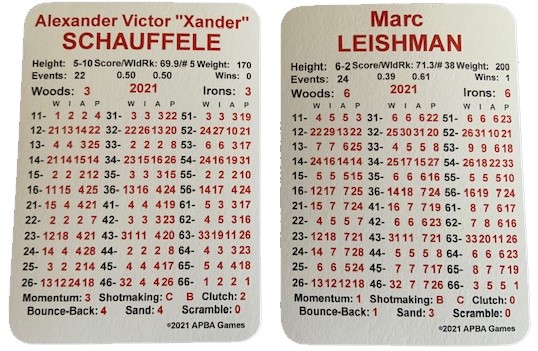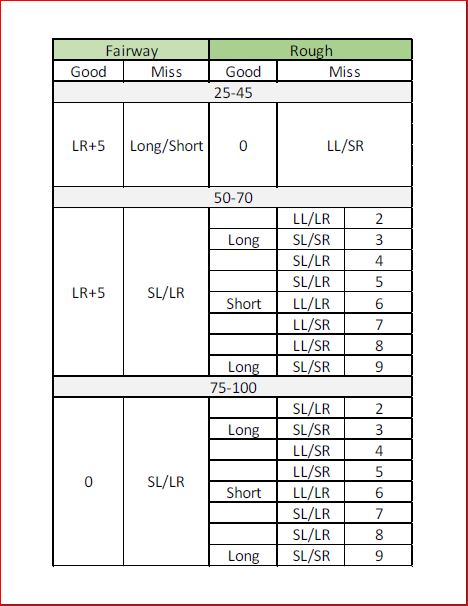In his recent post, Scott (smohler9) discussed the importance of roughly understanding the odds when planning shots. I want to take that a step further and look at Approach shot tendencies based on lie and the player’s Average I.
While the Average I bonus does not apply to Approach shots, Player Result Numbers (PRNs) in the “A” column are distributed around it for single-digit outcomes. Here are two examples.

Notice that Schauffele has an Average I of 3 with only 2’s, 3’s, and 4’s as single-digit results in the “A” column, while Leishman has an Average I of 6 with only 5’s, 6’s, and 7’s as single-digit results.
You can use this information to narrow down the likelihood of where Approach shots are going to end up when hit from the fairway or rough. But first, you have to consider (and perhaps, change) the path the shot will take to its target.
The Approach Caddie permits approaching the target in two ways. It can be along the primary axis measured 5 yards per grid-line (the longer path) or the secondary axis measured 5 yards for every 15 yards (the shorter path). If a ball is located due North, East, South, or West of the target, no secondary axis exists, and there is just one path for that shot. The Path button allows the user to pick the best approach for managing good shots that may just miss the target.
When pins are located at the very edges of greens (less than a full square away), the user may also want to consider the best path based on APBA board game tendencies for shot distributions. For FW or Rough lies, I have mapped these tendencies and they are included in the table below.

How to Read the Table
- Everything shown is an Approach shot result from the respective yardage distance boards.
- “Great” shots are PRNs of 12, 24, or 36 and are not shown in the table.
- “Good” shots are PRNs of 3, 6, or 9 and are represented in the table. They will either be on target or one grid-line away.
- A “Miss” is one number up or one down from the PRNs of 3, 6, and 9 (i.e., 2, 4, 5, 7, 8) and are represented in the table. While they can be effective shots, they are just not termed “Good” shots for the table’s purposes. A “Miss” will be either one grid-line or one diagonal off target.
- Really bad shots are not shown in the table.
- 0 means the shot was on target.
- LR+5 means the user chooses the result at either 5 yards left or right of the target.
- SL means the result is one diagonal short and left of the target; SR is one diagonal short and right of the target.
- LL means the result is one diagonal long and left of the target; LR is one diagonal long and right of the target.
- Long means the shot is one grid-line long of the target; Short means the shot is one grid-line short.
- Sand shots are not shown in the table. Their results are too variable to record here. For sand shots, check the APBA shot boards. For longer sand shots, playing to the center of the green usually makes the most sense.
- The results of working-the-ball are not factored into the table.
Notice that the tendencies change with distance from the target. For misses from the rough, consult the player’s Average I to see what works best for that type of player. For example, a player in the rough 55 yards from the target, with an Average I of 6, would miss Long Left or Long Right by one diagonal, if he gets a PRN of 5 or 7.
A good shot (i.e., a PRN of 3, 6, or 9) for that same player would be one grid-line short or long of the target. Were the player in the FW at that distance, a good shot would produce a LR+5 result, and a miss (i.e., PRN of 5 or 7) would be Short Left or Long Right of the target by one diagonal.
Knowing these tendencies is particularly important around the tiny greens of Yatch Club and Seaside, or for any course with most of the pin placements at the edges of greens or adjacent to hazards, such as Peachtree. This little table makes it a bit easier to quickly navigate these situations for best results.